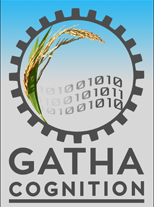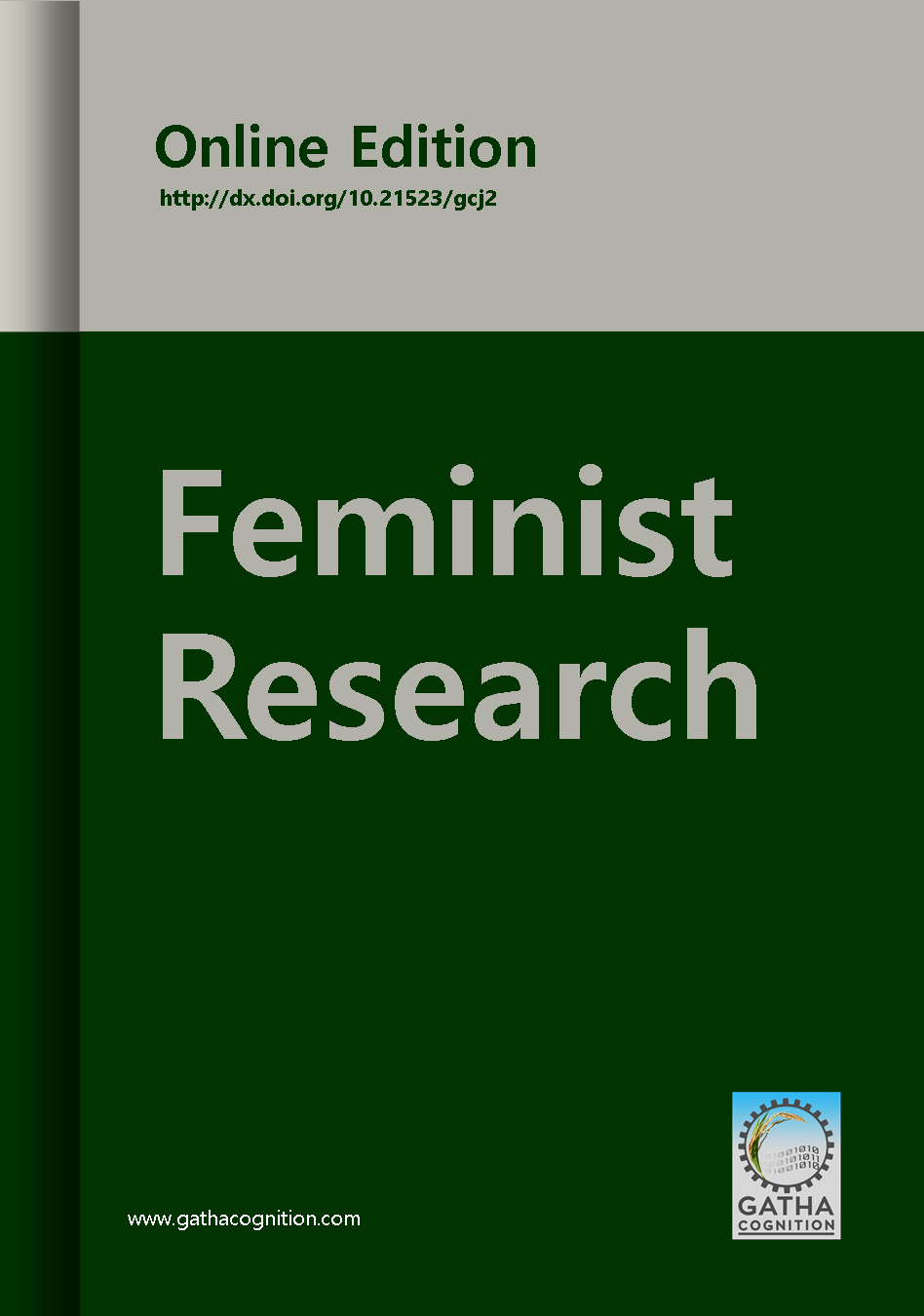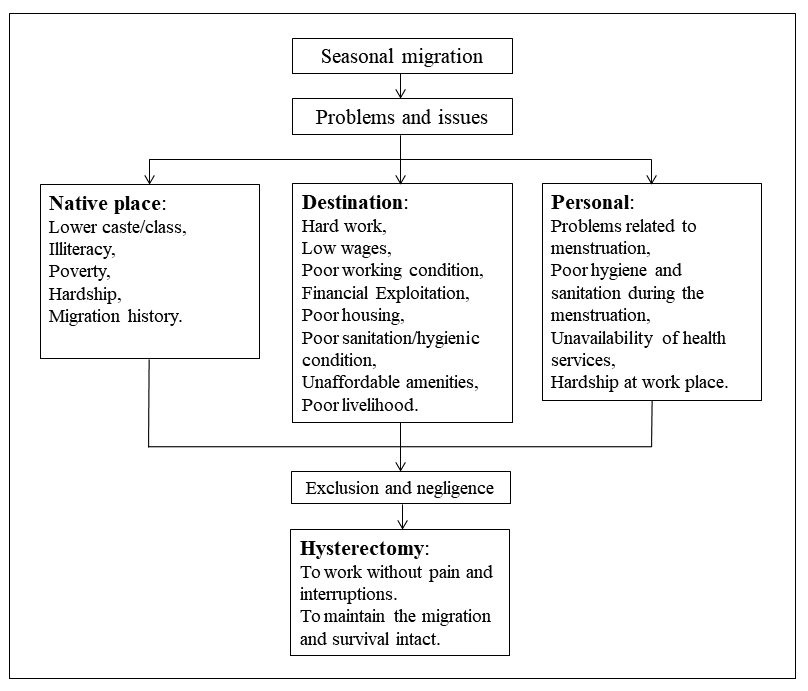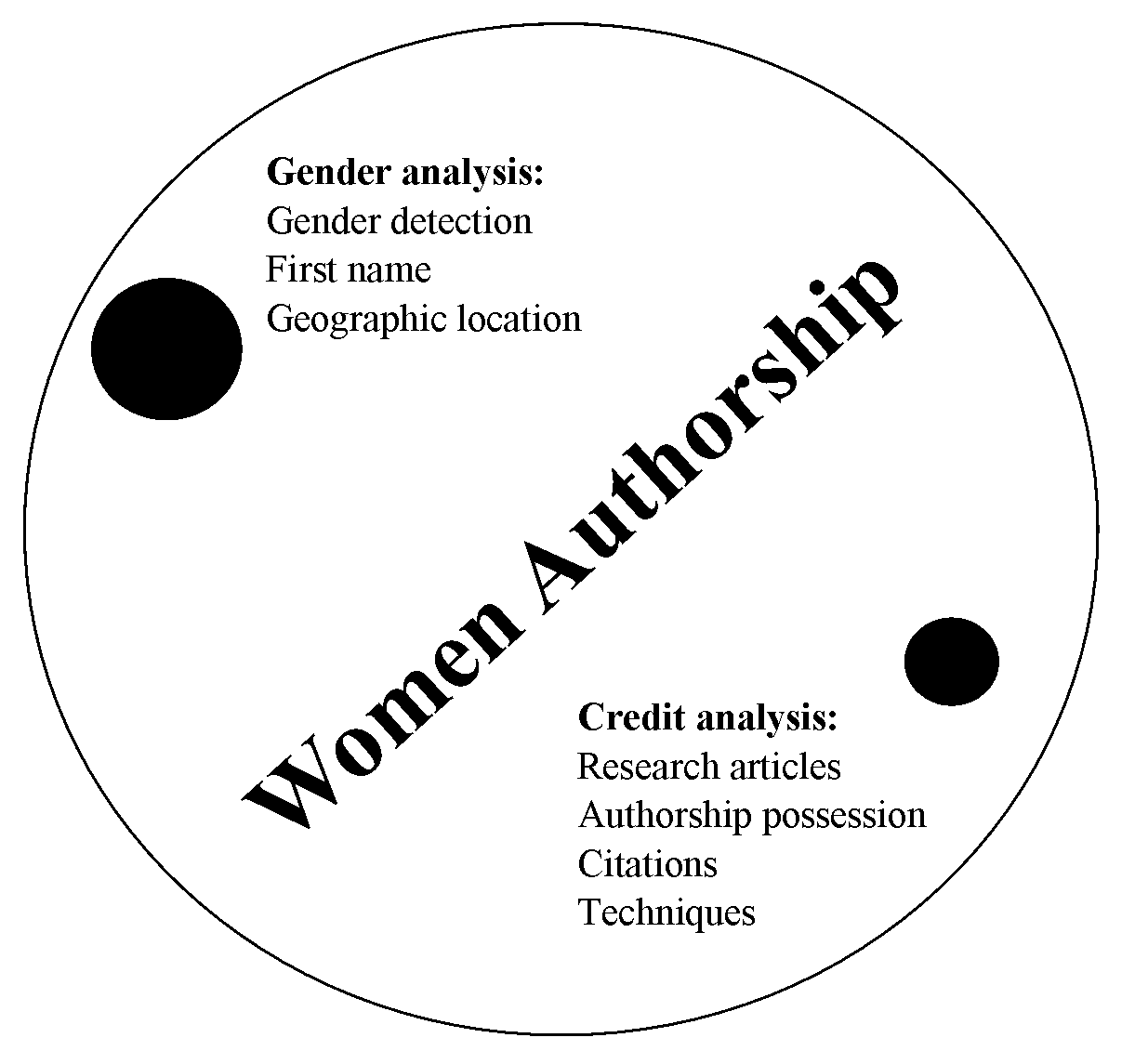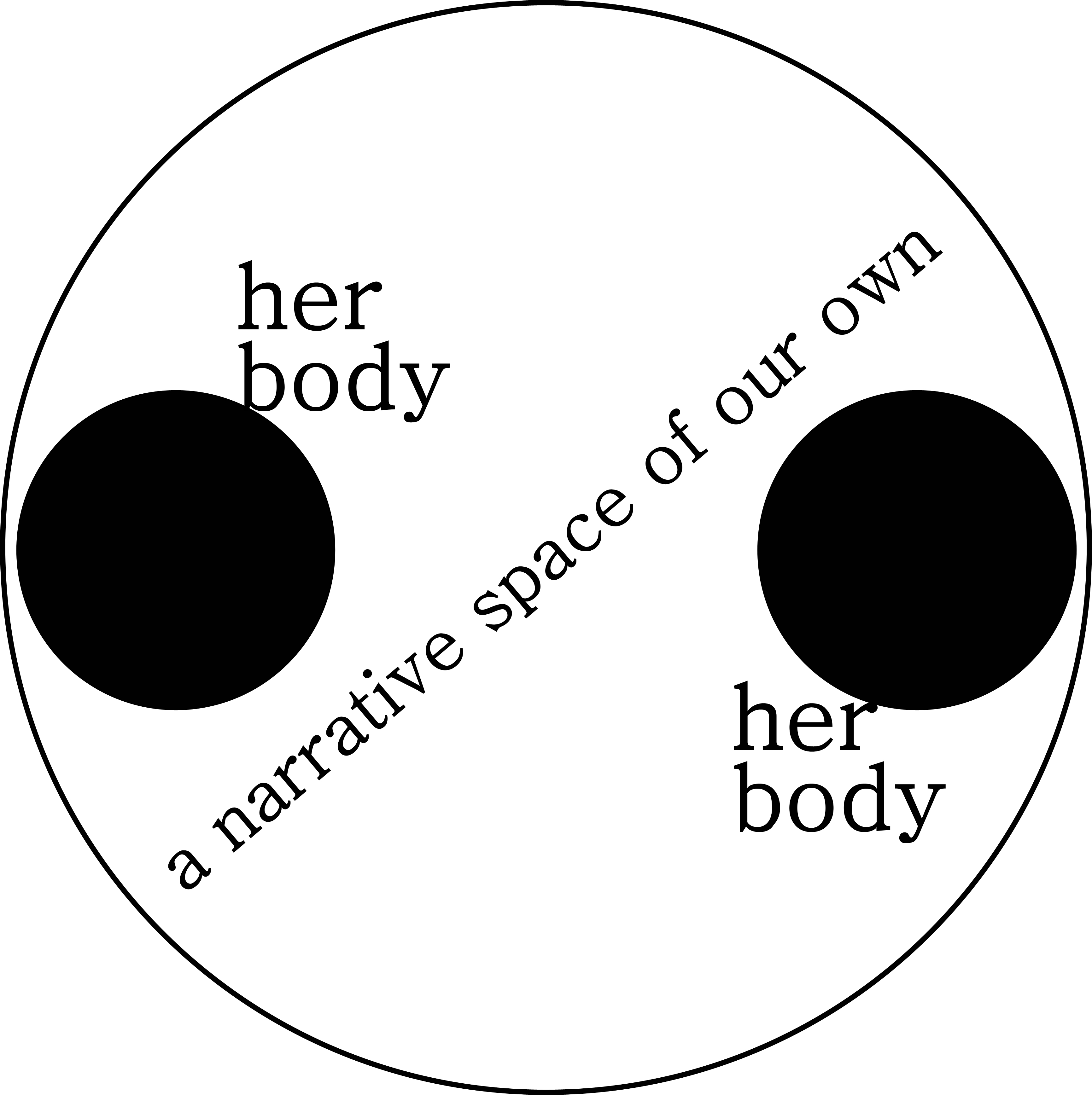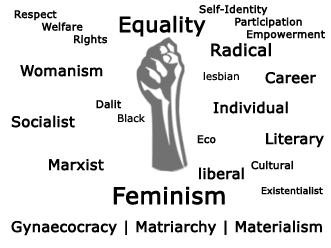1 . INTRODUCTION
Every year sugar belt of Maharashtra, India, needs workers for sugarcane harvesting. People from the drought-prone areas of Maharashtra fulfill this need. These people migrate seasonally towards the sugar belt. They face many problems after migrating and working as a sugarcane cutter (Abbas, 2016; Bansode, 2013; Kendre, 2011; Jugale, 2012; Shinde, 2019). The problem of hysterectomy among women is one of them. In 2019, in Maharashtra, the issue of hysterectomy among the women sugarcane cutters was highlighted at many levels. Exclusively, cases of hysterectomies among the women sugarcane cutters from the Beed district of Maharashtra were on the board of argument in the media and on various platforms. It is because the prevalence of a hysterectomy in the Beed district was high among the women sugarcane cutters (Jadhav, 2019; Chatterjee, 2019). Different arguments tried to establish the causality of women removing their wombs in the discussions. Few people have argued that removing the womb is the prerequisite to working as a sugarcane cutter, for which the contractors were assumed as the perpetrators.
In April 2019, the first argument prevailed that contractors do not hire women who menstruate (Jadhav, 2019). After investigating cases, few people argued that there is no force of contractors on women to perform hysterectomies. On the other side, it was in the observation that few private hospitals and doctors were promoting the operations through the financial exploitation of these women. Few people raised this issue from the perspective of human rights.
Consequently, the Maharashtra government set up a committee to explore this issue deeply. Then, in August 2019, the committee found that about 13000 women sugarcane cutters from the Beed districts had removed their uterus. The reason behind it was to save the loss of daily wages. This committee identified the complexity of the problem and highlighted the need to solve the issue through an awareness program among the women (Mulye, 2019). Before the issue of hysterectomies, many researchers and academicians highlighted different problems of sugarcane cutters. However, the health of these workers, especially women’s health, is an unexplored area. The exposition of the surprising practice of removing the uterus has made everybody think multilaterally about these workers.
Despite all the discussions, a few questions are essential to consider while inspecting the issue of hysterectomies. Why do women remove their wombs if there is no force from the contractors? What are the proximal factors where women become the victims of the promotion of hysterectomies by private doctors? Why their involvement in sugarcane cutting is put them in a risky row? What are the consequences women have to face when involved in sugarcane cutting? All the questions point out the need for deep inspection of this particular issue where one could understand different perspectives from the women involved in the practice of removing the uterus.
With all available background information and unanswered questions, this research paper provides some insights that can be essential to understand and solve the issue of hysterectomies. It explains the circumstances around these women while working as sugarcane cutters. It also illuminates the phenomenon of seasonal migration and its possible consequences on women’s health. In short, the paper aims to provide some insights into the work of sugarcane cutting and its impact on women’s menstrual health from the experiences of women sugarcane cutters in the destined villages in Maharashtra. Moreover, it explains possible reasons for the hysterectomy from women’s perspectives with hysterectomies. In the paper, women’s perspective on hysterectomy and sugarcane cutting may help resolve many problems of sugarcane cutters in Maharashtra.
3 . RESULTS
3.1 Socio-Economic Background of Hysterectomy Cases
All cases (5) were from different communities like Vadar, Bhil, Lamani, and Banjara. They were migrated from Beed, Jalna, Jalgaon, and Hingoli districts of Maharashtra and the lower socio-economic strata. All of them were involved in sugarcane cutting for 15 to 30 years. Drought conditions and work unavailability at their native places were the main reasons to migrate towards the sugar belt. Out of them, four women were illiterate, and one was educated up to the primary level of education. All the cases got married before the age of 18 years. They removed their uterus only after getting involved in the sugarcane cutting and achieving their expected family size by giving birth to children. Along with social background, it is essential to comprehend the living conditions of these workers after the migration and women’s perspectives on the work of sugarcane cutting and its impact on women’s health. Important to note that in the present study, facts related to the socio-economic status of women sugarcane cutters are almost similar to the other prior research work of different researchers (Bansode, 2013; Kendre, 2011; Jugale, 2012; Shiralkar et al., 2019).
3.2 Living Conditions After the Migration
At the destination, workers live without housing, electricity, provision of drinking water, and other basic amenities. These conditions indirectly support the fact that these workers are away from the rest of the sanitary measures. They live in small tents (huts) made out of plastic sheets or bundles of sugarcane trash. There is no provision of bathrooms and constructed toilets for these workers. Furthermore, they perform all the sanitary activities in the open field. The situation for women becomes worse, especially during menstrual days. As informed by the cases, women mostly use cotton clothes as the pad material during their menstrual cycle. They wash those clothes after use and again use the same clothes for nearly six months. They soak their menstrual clothes somewhere outside, where they have to keep one more cloth to hide the menstrual cloths.
3.3 Women’s Perspectives on Sugarcane Cutting
According to the women, ‘no one would be happy to work as a sugarcane cutter; it is not as simple as it looks.’ They also describe sugarcane cutting as “the work of the run” where one has to forget food, bath, and recreational activities on time. The work burden on these workers is visible, which one can understand through the observations. There is no particular timetable to work; there is no proper regulation on a weekly holiday; therefore, workers cannot access health services when needed. Importantly, these workers avoid the breaks during working hours, as they have to complete their targets, and based on the number of tons (1000kg) of sugarcane, they get their salary. In the whole season of sugarcane cutting, women have to bear the extra burden of work, as they also have to perform domestic work along with sugarcane cutting.
3.4 Work During Menstruation
Women carry loads of sugarcane and walk on the slippery trash of sugarcane towards the parked vehicle even during their menstrual cycle. There is no exemption from work during the menstrual cycle even if they face pain, so they have to bear the pain and work. Hence, it is essential to look at how sugarcane cutting affects women’s menstrual health. Most women use cotton clothes as their pad material, repeatedly. Because of those clothes, women get wounds between the thighs. We find the same situation even in the general population or rural areas. However, women sugarcane cutters use old clothes as the pad material and still walk for a longer time through the slippery trash of sugarcane in a particular fashion. As a result, they get wounds between two thighs because of friction. In that situation, it becomes challenging to walk with loads of bundles of sugarcane. Sometimes, it is unbearable that women cry while walking, but their work duty has no option. Women also shared that they apply coconut oil to the wounds at night to make it feel easy to work the next day again. In addition, because of no weekly holiday, women cannot access health services even while suffering from menstrual-related problems or any other health problem. Women reported “no time” as a reason for not treating the problem. Many women said they do not have time to take a bath because of this work, so they are away from accessing the services.
Along with that, the reasons like no money, fear of getting less salary, and unawareness about health service availability at the destination were the reasons for not accessing the health services. A vital fact is that neither the authorities of sugar factories nor the public health services have recognized the unique health needs of these workers. Nobody is to take responsibility or provide health services to workers. With the above-stated background information, it would be easy to understand what the cases of hysterectomies have experienced while working as a sugarcane cutter.
For example, let us read what 35years old Ganita (name changed) from the Beed district has to say.
“We have to work very hard, need to uplift burden of bundles of sugarcane or any heavy work; it is because we never get work which is easy and simple. Women do not get rest after their delivery, or they do not get rest during menstrual days; they have to live inconveniently and without any safety where they work. We are involved in activities where we cannot take care of our health; women easily get abdominal pain, waist pain, and white discharge. The same thing happened to me. I had gone through terrible pain while working as a sugarcane cutter. It is not that I feel good or have a hobby of removing the uterus, but I was in so much pain and had the problem of white discharge and abdominal pain to a severe extent. Therefore, I removed it”.
In her experience, Ganita underlines many adversities of the women sugarcane cutters at the destination. She rightly points out the work burden, deplorable work conditions, poor livelihoods, the hardship of women, and health problems.
Ganita also shared that removing the uterus was a good decision; she visited the hospital on time; otherwise, she would have died as informed by the doctor. Apart from Ganita’s experience, few reports revealed that private hospitals in Maharashtra were involved in promoting and performing hysterectomies. Therefore, to explore cases like Ganita more deeply, clinical scrutiny is required to disclose whether all the women who removed the uterus had severe problems and they would have died without surgery or not?
Further, the responses of Vandabai, Neeta, and Shitu are worth mentioning as they regret the surgery. Vandabai (32 years old) from the Hingoli district shared that she had severe abdominal pain, and the doctor said it was because of lifting weight. However, she chose to migrate to work as a sugarcane cutter, where lifting bundles is required. Hence, she opted for surgery to remove the uterus, but now, she faces the pain even after surgery. Therefore, she commented, “if a woman has a severe problem where there is no option other than a hysterectomy, it is fine, but just for sugarcane cutting, removing the uterus is nothing but inviting ill health.”
Similarly, nearly 45 years old, Neeta migrated to work with her son and daughter-in-law from the Beed district. Neeta removed her uterus 15 years ago. She was involved in sugarcane cutting for more than 30 years. However, now she believes that one should not prefer removing the uterus. Even today, after performing surgery, she faces many health problems. Neeta tries to justify her act of performing surgery by saying that when she removed her uterus (15 years ago), women used to discuss how removing the uterus is good to maintain purity in society. By discussing things with each other, many women removed their uterus. She also mentions that Mukadams (team leaders) do not force to remove the uterus, but there is so much pain in the work of sugarcane cutting.
Neeta further said she was suffering a lot, and she thought surgery would be the way out, but the opposite happened. After surgery, her suffering increased; now, she cannot work, but she has to work every day with a cry. As shared by the cases, they got problems related to the menstrual cycle, or it became more severe after their involvement in sugarcane cutting. Furthermore, many women repeatedly highlighted that there are no holidays and breaks during the work. As a result, workers do not get time to access required health services. More importantly, they cannot afford to rest during pain as they care about salary reduction. Therefore, removing the uterus is perceived as an alternative way by women. Further, nobody from the cases and other women workers reported that the contractors or the teams’ owners forced women to the hysterectomies. However, all five cases removed their uterus in a private hospital, where women were told that a hysterectomy was a good option for them. Therefore, the experiences of these women give hints to solving the issues of hysterectomy comprehensively.
 ,
Bal Rakshase 1
,
Bal Rakshase 1




